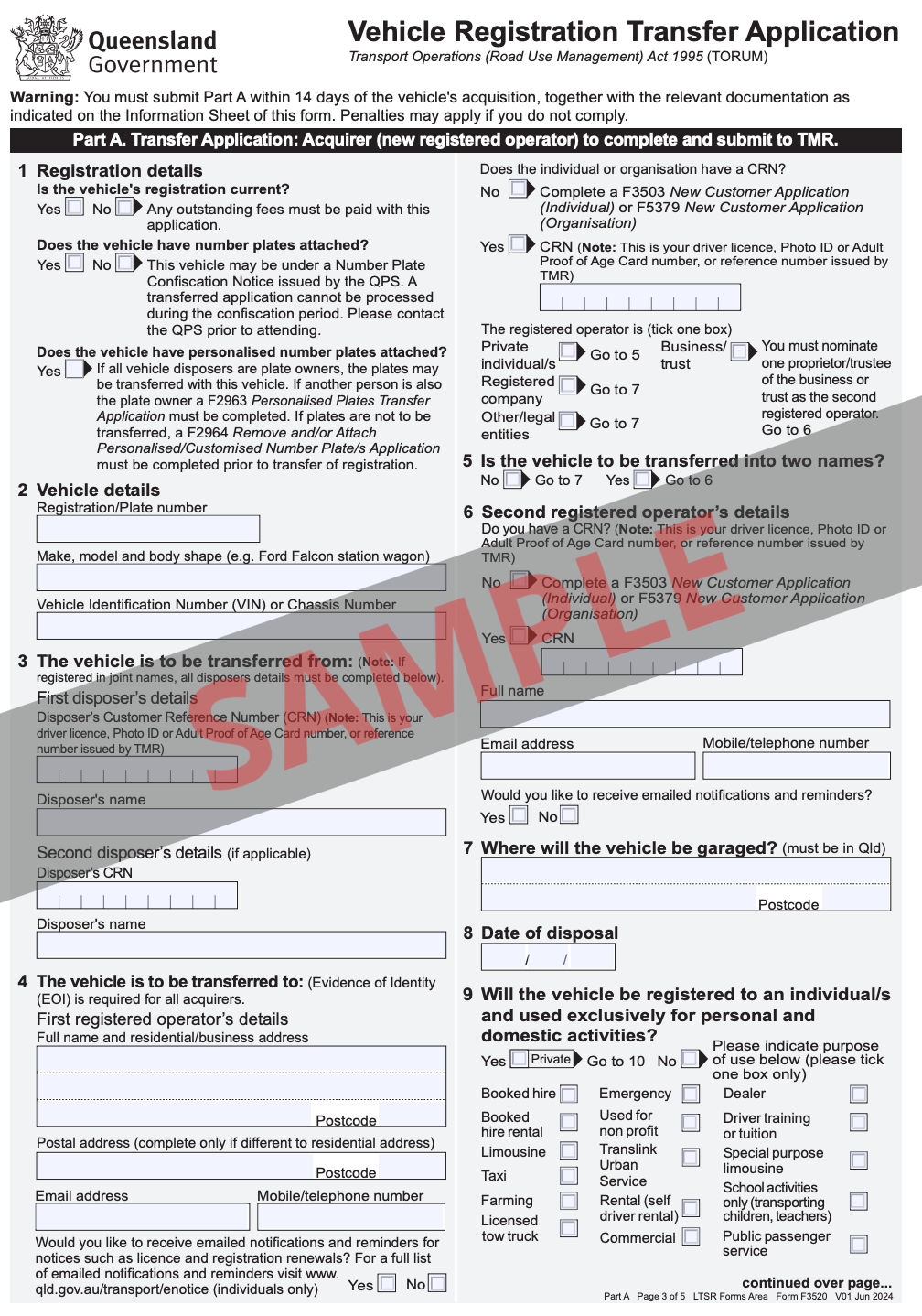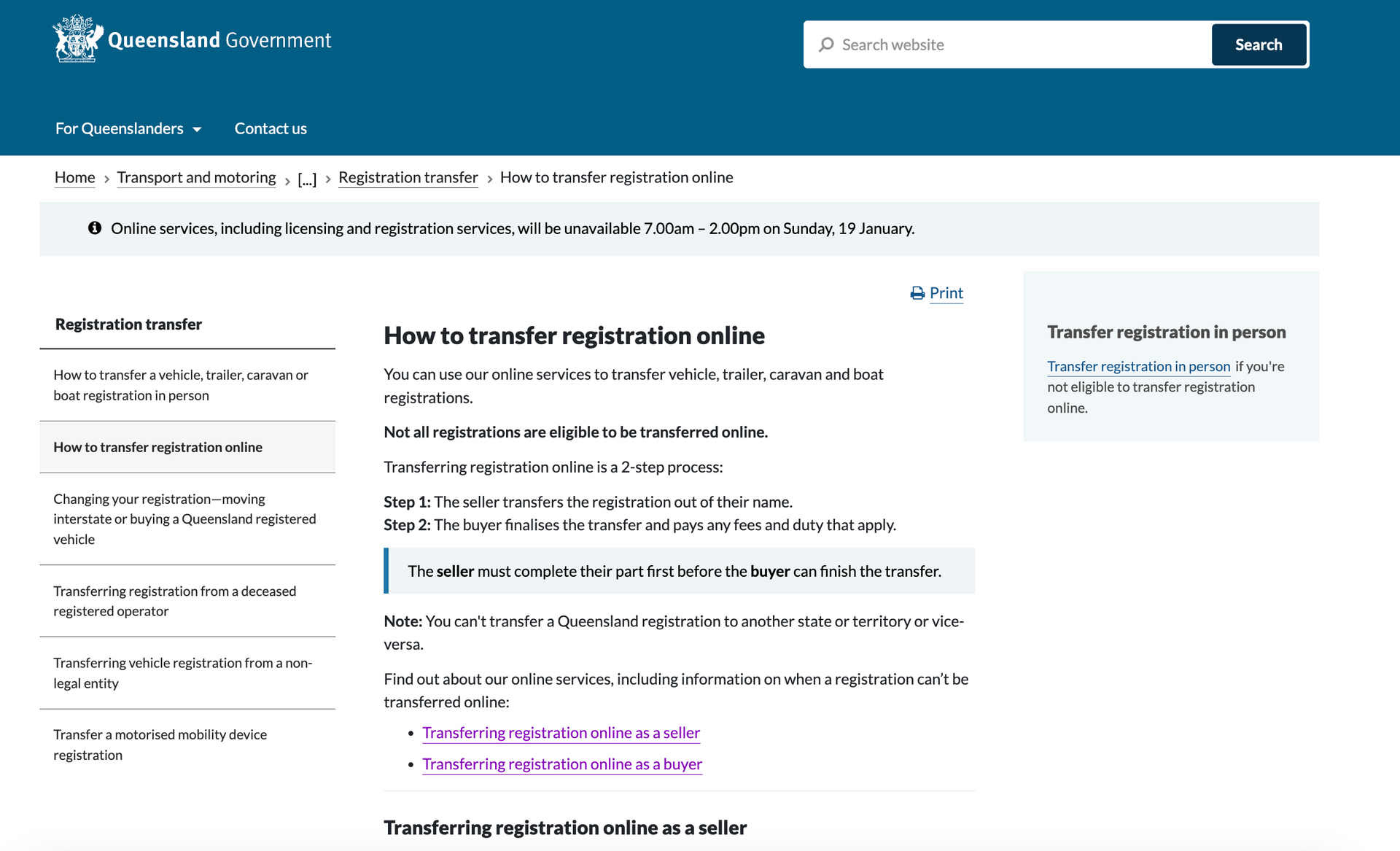How to Transfer Car Registration in Queensland (QLD)
Buying or selling a car in QLD might seem simple—just hand over the keys, right? Not quite. One critical detail often overlooked in the excitement of a car changing hands is transferring the ownership.

How To Complete a QLD Rego Transfer | Step by Step
Vehicle transfer paperwork is not glamorous, but it’s essential. Without it, the new owner can’t legally drive on Queensland roads, and the previous owner might still be on the hook for fines or tolls.
Here’s the deal: transferring a car’s registration isn’t just a polite formality—it’s the law. The responsibility to get the paperwork sorted is shared by both the buyer and seller. And failing to act quickly? That can lead to penalties no one wants to deal with.
Whether you’re dealing with a car, motorcycle, or even a boat, understanding the process for registration transfers and QLD stamp duty fees are crucial.
Where to Find the QLD Vehicle Registration Transfer Form
The Vehicle Registration Transfer Application Form (Form F3520) is required to transfer ownership of a vehicle in QLD. It includes details of both the seller and buyer, as well as the vehicle information.
It can be found by visiting the Queensland Transport and Main Roads website or via the link below.

How to Transfer Car Registration in QLD
1. Gather Your Documents
To ensure a smooth experience at your nearest customer service centre, make sure you have the following paperwork ready:
- A Valid Roadworthy Certificate (RWC): In QLD, you normally need a
Roadworthy Certificate (RWC) when selling a car privately.
- Proof of Identity: QLD driver’s licence or 18+ card. The most important thing here is your Customer Reference Number (CRN).
- A Completed Vehicle Registration Transfer Application Form (F3520): This form is required to transfer ownership of the vehicle. It includes details of both the seller and buyer, as well as the vehicle information.
Sometimes required:
- Sale Agreement or tax receipt: helpful but not mandatory.
- Personalised Number Plates: If you're attaching them.
2. Notify the Buyer or Seller
Communication is key. The seller should notify the Department of Transport and Main Roads (TMR) of the sale, and the buyer must complete the vehicle transfer form. This can be done online or in person at a TMR service centre.
3. Pay Transfer Fees and Stamp Duty
Buyers are responsible for paying:
- A registration transfer fee of $31.50.
- Stamp duty, based on the car’s purchase price or market value.
4. Complete the QLD Vehicle Transfer Form
- Online: Head to the TMR Portal, where you can complete the form and handle the transfer all online.
- In Person: Bring everything to your nearest TMR office for assistance.

Helpful links:
💡
Selling a Car Without A Roadworthy
🤔
How Long Does a QLD RWC Last?
How to Calculate Vehicle Stamp Duty in QLD
In Australia, vehicle stamp duty is a state-based tax applied when transferring ownership of a vehicle. Each state and territory has different rates and calculation methods.
Queensland Stamp Duty Rates
Dutiable Value up to $100,000:
- $2 per $100 for 1-4 cylinder/hybrid/EVs
- $3 per $100 for 5-6 cylinder
- $4 per $100 for 7+ cylinder
Dutiable Value above $100,000:
- $4 per $100 for 1-4 cylinder/hybrid/EVs
- $5 per $100 for 5-6 cylinder
- $6 per $100 for 7+ cylinder
Queensland Car Stamp Duty Calculator
Transferring Ownership of an Unregistered Car
If you're looking to transfer the ownership of an unregistered car in Queensland, the process is slightly different.
You'll need to provide proof of ownership, such as a receipt or a written agreement, and ensure the buyer is aware of any requirements for roadworthiness or registration before the vehicle can be legally driven.
Navigating Rural Registration Transfers
Are You Eligible for Duty Exemptions?
Frequently Asked Questions
How Much Is It To Transfer Registration in QLD?
The transfer fee is $31.50 (as of January 2025). Additionally, you’ll need to pay stamp duty, which varies based on the car’s value, type and amount of cylinders. Luxury cars incur higher stamp duty, so it’s worth checking with the Queensland TMR Stamp Duty Calculator for an accurate estimate.
Can I Transfer Registration Online?
Yes. Queensland’s TMR portal makes online transfers a breeze—just ensure all documents are in order.
What Happens If I Miss the 14-Day Window?
Late transfers can result in fines, so don’t delay.
Who Pays the Transfer Fees: Buyer or Seller?
It’s typically the buyer’s responsibility, but this can be negotiated during the sale.
Final Thoughts
Transferring car registration in Queensland might seem daunting at first, but it’s pretty straightforward once you know what steps to follow. Staying organised, double-checking your paperwork, and getting everything sorted ahead of time will make things much smoother.
But hey, if paperwork isn't your thing or you're short on time, Sell Any Car Fast can handle the whole process for you. We'll sort out the details, save you time, and get you paid quickly—so you can focus on what matters most.







